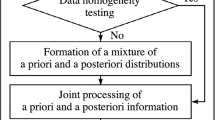It is proposed that multiple measurements be treated as a random sequential sample for probability estimates and a measurement procedure based on a sequential plan is constructed which will ensure fulfillment of specified limits on the probabilities of type 1 and type 2 errors with a minimum sample volume.




Similar content being viewed by others
References
H.-J. Mittag and H. Rinne, Statistical Methods of Quality Control [Russian translation], Mashinostroenie, Moscow (1995).
A. Wald, Sequential Analysis [Russian translation], Fizmatgiz, Moscow (1960).
A. I. Kibzun and Yu. S. Kan, Stochastic Programming Problems with Probabilistic Criteria [in Russian], Fizmatgiz, Moscow (2009).
Author information
Authors and Affiliations
Corresponding author
Additional information
Translated from Izmeritel’naya Tekhnika, No. 10, pp. 13–15, October, 2012.
Rights and permissions
About this article
Cite this article
Nazarov, N.G., Zelenkova, M.V. Forming an optimum experimental design for statistical estimation of the probability of a random event using random sequential sampling. Meas Tech 55, 1131–1136 (2013). https://doi.org/10.1007/s11018-012-0097-6
Received:
Published:
Issue Date:
DOI: https://doi.org/10.1007/s11018-012-0097-6




